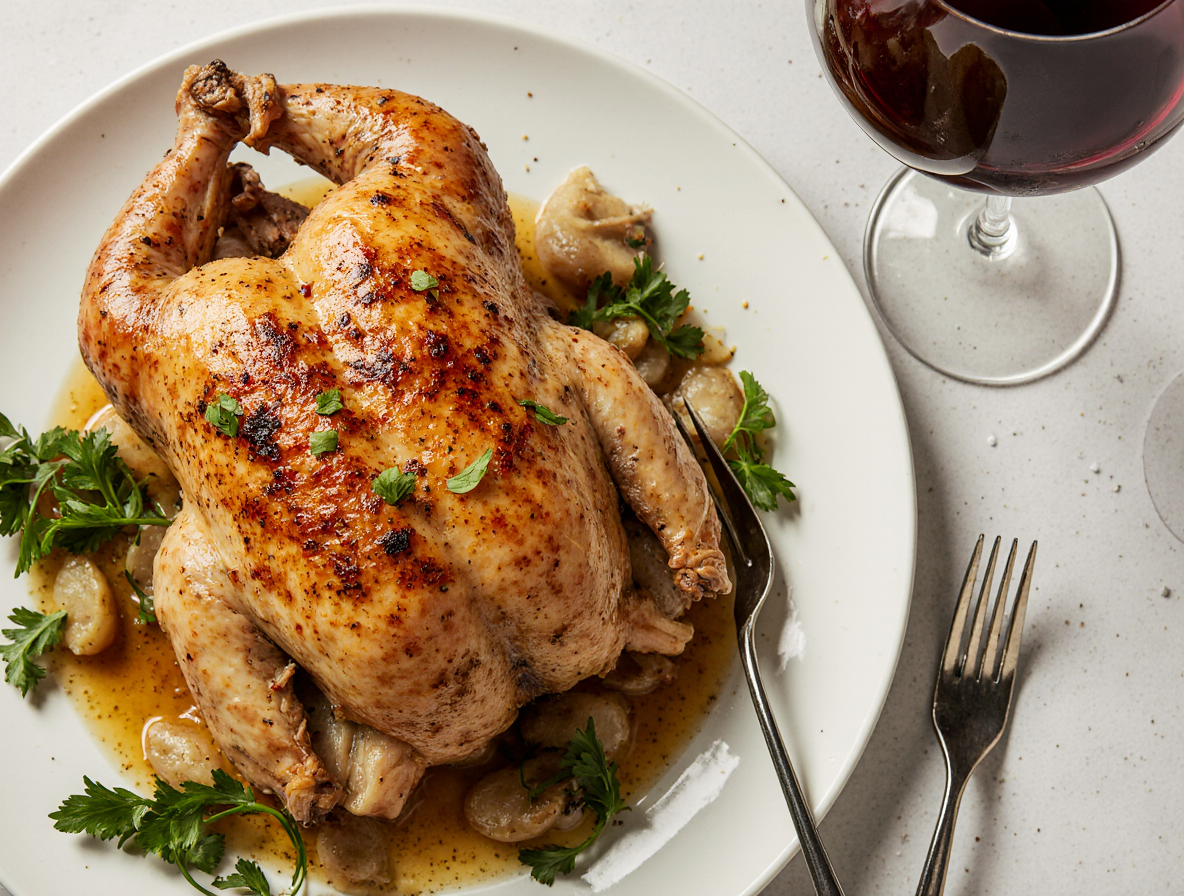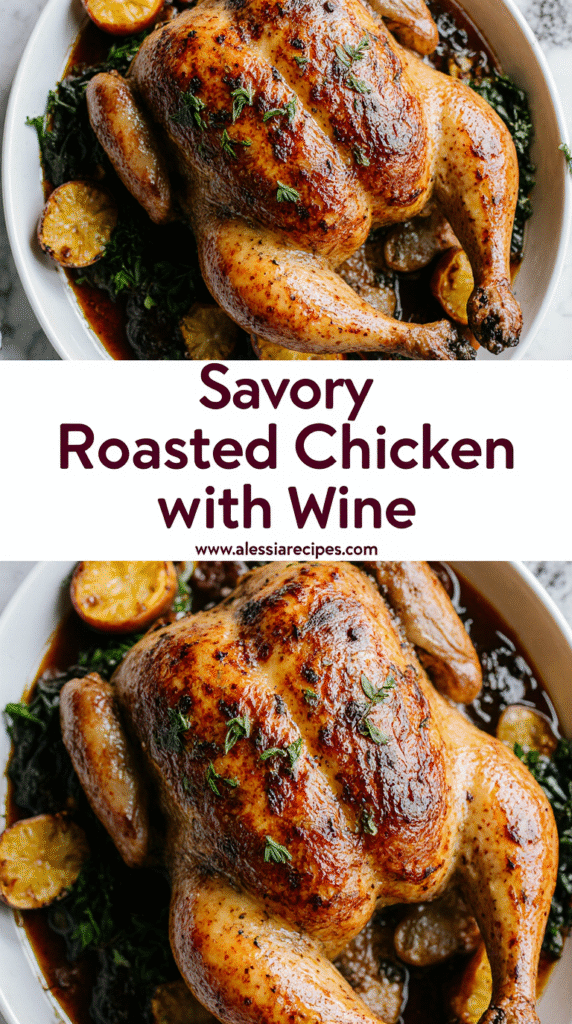How to Make Wine Roasted Chicken: A Foolproof Guide for Perfect Results
Did you know a whole chicken can feed your entire family, with leftovers, and usually costs under $10?
I’ve found that cooking wine with roasted chicken creates one of the most flavorful, impressive meals you can serve. Whether you prefer white wine roasted chicken or opt for a red wine version, this technique delivers incredible results every time.
Actually, there’s quite a debate about the perfect roasting temperature. Many recipes call for higher temps around 200°C, but I’ve discovered this can burn the skin quite easily. Instead, I prefer roasting at 180°C/350°F for a little longer, ensuring a perfectly cooked chicken that reaches the required internal temperature of 165°F.
Depending on size, your roasting time will vary – a 5 lb chicken typically takes about an hour and 45 minutes to cook thoroughly. But don’t worry about timing! You’ll know your chicken is done when the juices run clear after piercing the thigh with a skewer.
If you’re looking for a complete meal, this dish pairs beautifully with vegetables. You can roast them right in the pan with the chicken, but a fresh leafy salad also balances the rich flavors perfectly. And if you don’t consume alcohol, chicken broth with a squeeze of lemon juice makes an excellent substitute for wine.
In this guide, I’ll walk you through everything you need to know about creating the perfect wine roasted chicken, from selecting ingredients to serving suggestions.
Choose the Right Ingredients
Selecting the right ingredients makes all the difference in creating a memorable wine roasted chicken.
Best chicken cuts for roasting
For the most flavorful results, I recommend choosing a free-range chicken around 3.5 pounds that’s been fed an organic or natural diet. Free-range chickens generally offer more flavor than conventional ones. While chicken thighs are excellent for smaller meals, a whole chicken provides better value and versatility. Furthermore, using the entire bird allows you to make homemade chicken broth with the leftover bones.
White vs red wine for roasting
Though both red and white wines work with roasted chicken, your choice significantly impacts the final flavor. For everyday roasting, I prefer dry white wines like Pinot Gris, Sauvignon Blanc, or Chardonnay. Dry means the wine contains lower natural sugars and doesn’t taste actively sweet.
White wine creates a bright, aromatic flavor with slight acidity. Alternatively, dry red wine produces a deeper, richer taste profile. However, be cautious with red wine—it can sometimes turn the chicken a grayish color.
Essential herbs and aromatics
The classic herb combination for wine roasted chicken includes rosemary, thyme, and oregano. These woodier herbs stand up well to roasting temperatures. Additionally, parsley and sage contribute wonderful complementary flavors.
Garlic is non-negotiable—at least 4 cloves will provide amazing depth. Many recipes also incorporate Dijon mustard (about 1-2 tablespoons) to enhance the sauce. For the cavity, I stuff half a lemon along with extra herb sprigs to perfume the bird from within.
Optional add-ins for extra flavor
To elevate your wine roasted chicken even further, consider these flavorful additions:
- Lemon or orange zest for citrusy brightness
- A pinch of red pepper flakes for gentle heat
- Cinnamon, coriander, or fennel seeds for aromatic depth
- Bay leaves for subtle earthiness
- Soy sauce and brown sugar for a sweet-savory dimension
Don’t forget the vegetables! Carrots, pearl onions, and potatoes roasted alongside the chicken absorb the wine-infused juices, creating a complete one-pan meal.
Step-by-Step Roasting Process
Transforming raw ingredients into a perfectly roasted chicken requires attention to detail and proper technique. Let’s dive into the practical process that makes wine roasted chicken so special.
Prepping the chicken and cavity
Firstly, remove the chicken from its packaging and discard the giblets. Pat the bird completely dry with paper towels, as this helps achieve crispy skin. For exceptionally crispy results, let the chicken sit uncovered in the refrigerator for a few hours beforehand. Before cooking, loosen the skin on the breast and thighs to create space for your flavorful ingredients.
Making the wine and herb marinade
Combine 1 cup of wine (dry white wine is ideal for everyday roasting) with minced fresh herbs like thyme, rosemary, and parsley. Add 2-8 cloves of minced garlic depending on your preference. For extra flavor, incorporate 1-2 tablespoons of Dijon mustard into the marinade. Mix thoroughly until combined. For best results, marinate the chicken for at least 2 hours or overnight before roasting.
Roasting temperature and timing
Preheat your oven to 350-400°F (175-200°C). For a 4-pound chicken, roast at 350°F for approximately 1 hour and 15 minutes. Larger birds (around 5 pounds) require about 1 hour and 45 minutes. Throughout cooking, the internal temperature is more important than time—chicken is safely cooked when it reaches 165°F in the thickest part of the thigh. For crispy skin, consider starting at 425°F for 15 minutes, then reducing to 350°F.
How to baste for juicy results
Basting keeps your chicken moist and flavorful. Every 15-20 minutes, carefully open the oven and use a baster or large spoon to collect pan juices and redistribute them over the chicken. Avoid excessive basting, since opening the oven frequently lowers temperature and extends cooking time. During the last 15 minutes, brush with melted butter for a beautiful golden finish. After cooking, allow the chicken to rest covered with foil for 10-15 minutes before carving.
Tips for Flavor and Texture
The difference between good and exceptional wine roasted chicken lies in the details. These finishing touches elevate a simple dish into something truly special.
How to get crispy skin
For that coveted crispy exterior, moisture is your enemy. Thoroughly dry the chicken with paper towels before applying any oil or seasonings. Moreover, letting your chicken sit uncovered in the refrigerator for several hours before roasting significantly improves skin texture. This drying process is essential for crispy results.
When applying oil, ensure the skin is evenly but lightly coated—too much oil prevents proper crisping. Consequently, pour any wine around the chicken, not over it, to maintain dryness. For an extra-crispy start, preheat your oven to 450°F initially, subsequently reducing the temperature once the bird goes in.
Letting the chicken rest
Perhaps the most critical step: after removing your perfectly roasted chicken from the oven, resist the urge to carve immediately. Allow it to rest for at least 15-20 minutes. Ultimately, this patience prevents the flavorful juices from escaping—essentially keeping them locked within the meat instead of spilling onto your cutting board.
During this resting period, the chicken remains warm while the internal juices redistribute throughout the meat. This step is non-negotiable for juicy results.
Using pan drippings as sauce
Those golden drippings at the bottom of your roasting pan represent concentrated flavor. Specifically, create a simple sauce by adding ½ cup dry white wine to the hot pan, scraping up browned bits. For a richer sauce, reduce over medium heat until slightly thickened.
Alternatively, make a creamy sauce by adding 3 tablespoons heavy cream after reducing the wine. Strain through a fine sieve for the smoothest texture. These pan juices beautifully complement both white wine roasted chicken and red wine variations.
Serving and Pairing Ideas
Perfectly roasted chicken deserves thoughtful accompaniments to complete your dining experience. From sides to wine, here’s how to elevate your meal.
Best sides for wine roasted chicken
Complement your wine roasted chicken with sides that balance and enhance its rich flavors. Creamy mashed potatoes or crispy roasted potatoes with rosemary and garlic create a hearty foundation. For lighter options, consider:
- Sautéed haricots verts (French green beans) with garlic butter
- Charred broccolini or Brussels sprouts with Parmesan
- A fresh burrata salad with tomatoes and basil
Roasted vegetables like carrots, fennel, or asparagus absorb the chicken’s flavorful juices when cooked alongside it.
Wine pairing with roasted chicken
For white wine roasted chicken, Chardonnay creates a wonderful harmony—particularly white Burgundy. Alternatively, dry Pinot Noir stands out as an excellent red wine option, with its light body and bright fruit notes complementing rather than overwhelming the chicken.
Other excellent pairings include Champagne for a sense of occasion, Viognier for its apricot notes, or a dry Provençal Rosé that immediately transports you to the French countryside. For red wine roasted chicken, Grenache-based Côtes du Rhône or Syrah adds depth to the richer flavors.
How to store and reheat leftovers
After cooling for 30-60 minutes, remove meat from the bones and refrigerate in airtight containers for 3-4 days. For best reheating results, add a splash of broth to prevent dryness. The oven method (350°F for 20-25 minutes with foil and a bit of liquid) preserves juiciness best.
Conclusion
Wine roasted chicken truly stands as one of the most impressive yet accessible dishes anyone can master at home. Throughout this guide, we’ve explored everything from selecting quality ingredients to perfecting that crispy, golden skin. Making this dish allows you to create a restaurant-worthy meal without breaking the bank.
After trying both white and red wine variations, I can confidently say that each offers its unique character to the final dish. White wine creates that bright, aromatic profile perfect for family dinners, while red wine delivers deeper, richer flavors ideal for special occasions. Regardless of your choice, the combination of wine, herbs, and proper technique transforms an ordinary chicken into something extraordinary.
Remember that patience plays a crucial role in achieving perfect results. Allowing your chicken to rest before carving makes all the difference between juicy, flavorful meat and a disappointing dry dinner. Similarly, taking time to properly dry the skin before roasting rewards you with that coveted crispy exterior everyone loves.
Most importantly, don’t waste those incredible pan drippings! They contain concentrated flavors that make an amazing sauce with minimal effort. Simply adding a bit more wine and reducing creates a restaurant-quality finishing touch that elevates the entire meal.
Wine roasted chicken pairs beautifully with countless side dishes, making it incredibly versatile for any occasion. From simple roasted vegetables to elegant salads, this dish adapts to your needs while always remaining impressive. Therefore, whether you’re cooking for a quiet family dinner or hosting friends, this foolproof method delivers consistent, delicious results every time.
Actually, once you’ve mastered this technique, you’ll find yourself turning to it again and again. The combination of affordability, impressive presentation, and incredible flavor makes wine roasted chicken a staple recipe worth perfecting. Give it a try this weekend – your family and friends will undoubtedly be asking for seconds!
FAQs
Q1. When is the best time to add wine during the chicken roasting process? Add wine about 20-30 minutes into the roasting process. Pour a generous amount of wine into the roasting tray, then return the chicken to the oven to continue cooking. This allows the wine to infuse the chicken with flavor as it roasts.
Q2. What type of wine pairs best with roasted chicken? For white wine roasted chicken, a Chardonnay or Sauvignon Blanc complements the dish well. If you’ve used red wine in cooking, a light-bodied Pinot Noir or Grenache-based wine like Côtes du Rhône pairs nicely. The choice depends on the flavors in your specific recipe.
Q3. How long should I marinate chicken in wine before roasting? For best results, marinate the chicken in wine for at least 2 hours or overnight. This allows the flavors to penetrate the meat thoroughly. However, if you’re short on time, even a brief 30-minute marinade can enhance the flavor.
Q4. What’s the secret to achieving crispy skin on wine roasted chicken? To get crispy skin, thoroughly pat the chicken dry before cooking and let it sit uncovered in the refrigerator for a few hours. This drying process is crucial. Also, avoid pouring wine directly over the skin during cooking, and consider starting at a higher oven temperature before reducing it.
Q5. How should I store and reheat leftover wine roasted chicken? Store leftover chicken in airtight containers in the refrigerator for up to 3-4 days. When reheating, add a splash of broth to prevent dryness. For best results, reheat in the oven at 350°F for 20-25 minutes, covered with foil and with a bit of liquid added to maintain moisture.


